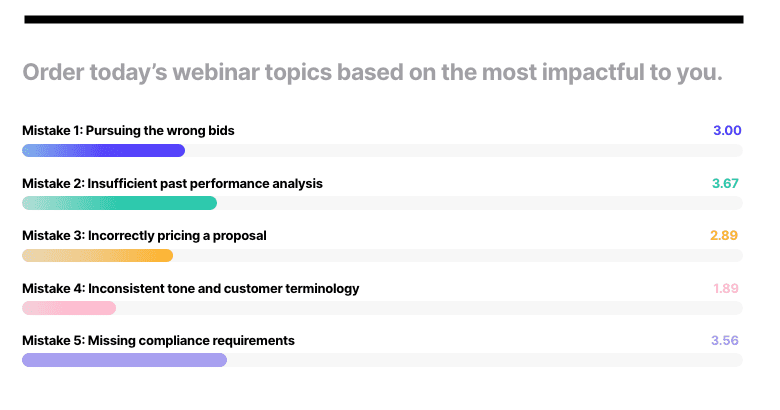In our webinar, “Top 5 reasons for losing multi-million-dollar bids”, we explored the common mistakes of proposal and business development teams. We identified the five key points of failure when preparing a bid. And presented helpful solutions and examples to help you win more business.
- Pursuing the wrong bids
- Insufficient past performance analysis
- Incorrectly pricing a proposal
- Inconsistent tone and customer terminology
- Missing compliance requirements
We surveyed the webinar attendees. The most important topics to registrants were ‘avoid pursuing wrong bids’ and ‘insufficient past performance analyses’. However, it was clear that our audience felt all five pain points were relevant and commonly impact win rates.
Pursuing the wrong bids
There is nothing more frustrating than putting in many hours of work on a poorly qualified bid. All these hours equal valuable dollars wasted and opportunity cost when you and your team could have been putting those resources into other more suitable pursuits. A ‘we bid on everything culture’ is not a good strategy. It can leave you open to reputational damage if later you realize you do not have the capabilities or resources to deliver.
These are just some of the many challenges faced when trying to avoid pursuing the wrong bids. Our webinar covered these challenges but here were the highlights:
- To avoid a ‘we bid on everything’ culture, ask the right questions and revisit pursuit decisions as conditions change.
- You can avoid reputational hits and/or cost overruns by ensuring your organization has the capabilities and the resources to deliver.
- Cease reflexive bidding based on assumptions and customer relationships to avoid exhausting scarce bid and proposal resources.
View the full webinar here

Insufficient past performance analysis
Understandably the ‘insufficient past performance analyses’ topic rated highly. It can be a time-consuming, very manual, and tedious process to analyze dozens or hundreds of past contracts.
Looking for past performance evidence in content is a two-pronged issue. You could have hundreds of past contracts that you have performed under. What is the best contract you can reference your current RFP under? And within that contract, we still need to pull out relevant sections of the SOW to show that evidence. And we need to highlight which labor categories we performed under.
This is very manual and tedious. A lot of teams spend too much time searching through contracts that are not compelling or relevant. And you end up missing some ‘diamonds in the rough’ through human error.
In our webinar we discussed this in-depth and gave tips to help your team with this issue.
- Automating this analysis can speed up your ability to identify the most relevant contracts. And within that contract you can drill down into aspects like style references and L-Cap tables.
- Instead of having two documents up on separate screens to compare side by side or relying on historical knowledge. With VT Docs you can review the RFP against your past performance content and that of partners/affiliates.
- Using customer themes and language to guide the analysis. Instead of using CTR+F and finding your way through based on past knowledge.
View the full webinar here

Achieving Compliance
Our attendees mentioned that non-compliance is one of the chief causes of lost bids. Compliance is a broad topic but a very important one. The minute an RFP comes in you must assess compliance with the requirements. Apart from the usual font type, size and zip file requirements for proposals. There are some layered important compliance requirements you need to identify quickly that will require review and assessment.
So, what can we do to achieve this?
- Identify disqualifiers like costs accounting standards, set-asides, etc., early and consistently in the process.
- As RFPs change with amendments, maybe things come out of Q&A periods, we want to quickly highlight changes and flow them to the right teams.
- Flag and identify these requirements that require subcontractor flowdown or action.
View the full webinar here

Time has an influencing role
Time is a huge factor when reviewing proposals for readability and quality standards. In our survey, we asked if you review proposals for readability and quality standards. 61% of the respondents said they ‘sometimes achieve this, but it is time dependent’.

We would like to see this ‘sometimes’ become ‘always’, but the time constraint here is key. From this answer, we can see teams are overburdened, and this review happens too late in the proposal process. Ideally, you want to review proposal content for consistent tone and reiterate customer language at early red-team and certainly well before it goes out the door.
In our webinar, we discuss your challenges in this reviewing process. And give you solutions that can save you time.
- A failure to incorporate the customer’s language. You can take advantage of a psychological element by mimicking the customer’s language. By doing this you signal that you know the customer and their disposition. You show alignment to the mission.
- If there are multiple authors on a proposal the language can be choppy and hard to read. Conducting a readability analysis of your proposal volumes throughout the proposal cycle will create a consistent tone of voice.
- Inconsistent content quality is a burden on evaluators. We can enforce consistency by automating the identification of watchwords and internal style guides. This will help with any inconsistencies and misalignments from a language perspective.
View the full webinar here

Analyzing win themes for persuasive language
Another interesting finding from our survey was that analyzing win themes in persuasive language was least done by respondents on recent proposals. This is a similar result to a previous survey conducted at our 2022 VT Summit. Regarding analyzing win themes, we learned that:
- 52% of organizations manually review the response documents and check adherence to win themes by hand.
- While 29% don’t have a process for analyzing win themes at all.
This suggests analyzing win themes (or your differentiation) is not a focus for most contractors. However, it is an effective way to help you differentiate from other competitors.
This is how we are beating the competition; this is how we are winning.
Karnita McElveen, Vice President of Operations and PMO at AMG
Karnita believes VisibleThread provided her with a platform to improve efficiency. And now she can use the space between lines to perform and be successful.
Other findings from respondents regarding their last proposal were:
- Most people conduct Spelling and Grammar checks.
- Most people also aim to reduce complex and long sentences.
- And many seek to reduce passive voice.

From these survey results, we have compiled a guide for you to refer to. Using the solutions provided above and, in the webinar, VisibleThread can help you save money and valuable time. And more importantly, help you beat the competition and win.
As a leading global aerospace company, Boeing develops, manufactures, and services commercial airplanes, defense products, and space systems for customers in more than 150 countries. On average, their proposal and contract review teams have found that they have saved 85% of the time per proposal. And have saved $1 million dollars per year for 20 users of VisibleThread within their organization.
By automating manual tasks as we discuss in our webinar, Boeing were able to significantly reduce their inefficiency and save many hours per proposal. This success has shown bid teams within other areas of the organization, as well as upper management, the value and worthwhile investment in automating key steps of the bid process.

Contact us today to see how VT can help you improve your bid process. And don’t forget to register for our upcoming webinars.
It’s a company where ideas and innovation are encouraged, and achievements are celebrated.
Claire Whelan, Senior Digital Marketing Specialist








